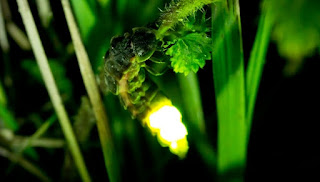You may have heard about living things that display colourful lights. In fact, plants like some fungi and algae species produce beautiful light at night. Fireflies produce light to attract prospective mates.
But some animals use their light for hunts or protection. Let's take some classic examples.
Hunts
Have you ever heard about a monstrous-looking fish called Deep-sea angler fish? These deep sea little monsters produce light using bacteria living in the pole, or long organ on its head. By producing light on this organ and moving it back and forth, they succeed at getting the attention of smaller fishes. These smaller fishes find this attractive, but unfortunately they are being deceived. They only realize this once it is too late because as soon as they get too close to the hungry monster who is hunting stand-still, they are eaten at once!
Protection
And you're in here for 'special treats.' We would consider three amazing underwater creatures here, so let's get started.
A first to consider is the Hawaiian bobtail squid. Like many other bobtail squids, they are bio-luminescent, that is, they display light. But there are two facts about their light-emitting ability that make them worthy of consideration: their light do not come from them and, unlike many other bio-luminescent organisms, their light makes them invisible.
At birth, bobtail squids do not have any light organs. But soon after birth, some light-creating bacteria called vibrio fischeri come to live in their underside. These bacteria trigger genes in the bobtail squids that then enable it to create light at will.
As for the use of their light, it is similar to what we learn in biology as counter-shading (possession of two different colours at the top and bottom sides of an animal, such as tilapia, for protection). At night, predators that swim underwater can easily see and feed on the bobtail squid by spotting their dark underside with the reflective light from the moon. As such, bobtail squids produce bright light in their underside to mimic the bright light above the water, thus making them invisible to animals below.
Another creature to consider is the Comb jellyfish. These jellyfish, which do not sting, protect themselves by displaying light around their bodies that look like flashes. As this flashing light do not make sense to predators, they often become confused and let the jellyfish alone.
The last creature to consider that displays light is the Lantern fish. These fishes, like bobtail squids, also glow to make their underside dark. Because they live deep in the sea and it is so dark under there, they display light that reveals only bright lines but hide the overall shape of the fish. This very bright light that looks like lines darken the remaining part of their body so that enemies can't even see any thing apart from light and background darkness all around.
It is also noteworthy that lantern fish use their bio-luminescence to attract preys and mates.





Comments
Post a Comment